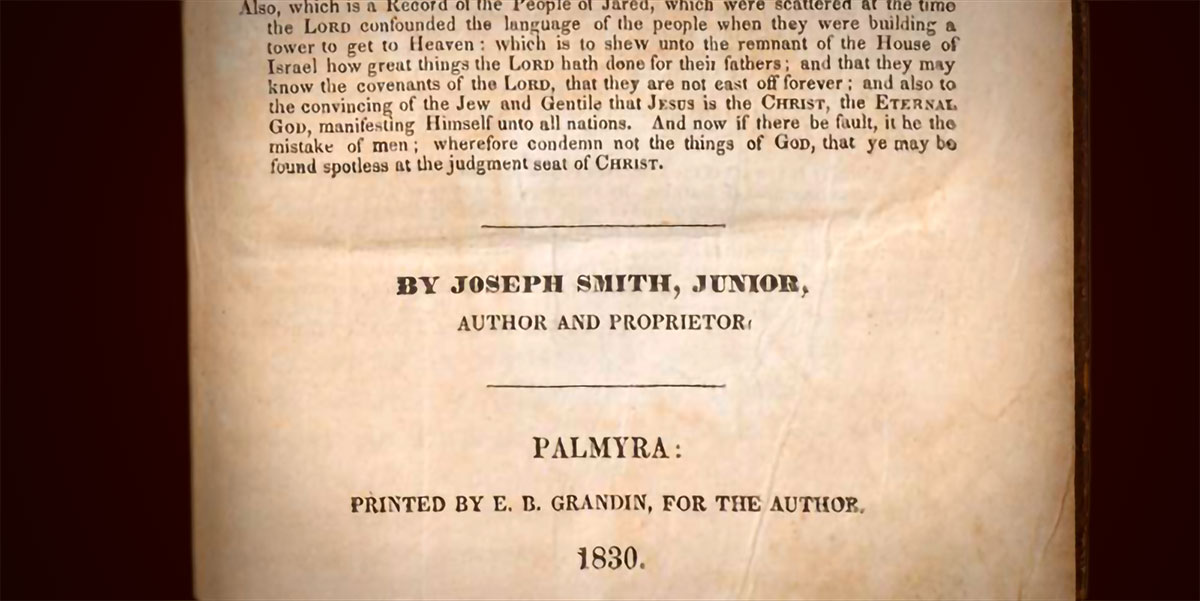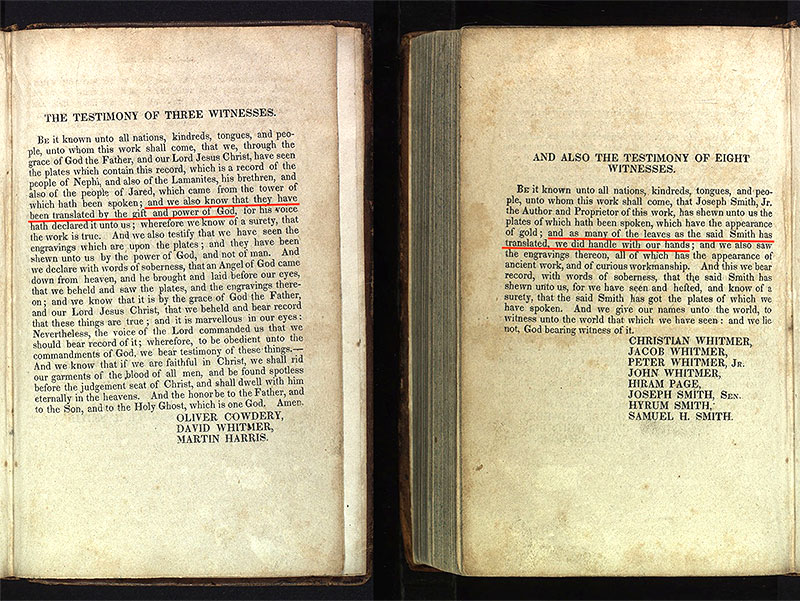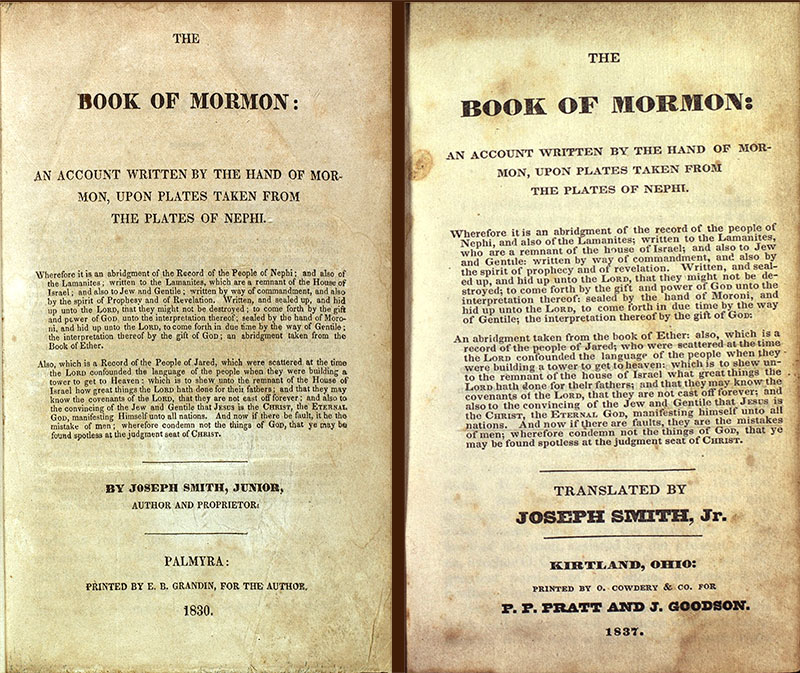
The Know
Latter-day Saints are accustomed to speaking of Joseph Smith as the inspired translator of the Book of Mormon.1 However, the title page of the first edition of the Book of Mormon (published in 1830) identifies the prophet as the “Author and Proprietor” of the book, not the translator. Joseph Smith was first named the translator of the Book of Mormon on the title page in the second edition of the book published in Kirtland, Ohio in 1837.2
At first glance, this might seem like Joseph made contradictory claims about his role in bringing forth the Book of Mormon.3 This conclusion, however, is not warranted for many reasons. It has long been recognized that designating Joseph Smith as the “author and proprietor” of the Book of Mormon in the first edition was done to conform to copyright law.4 In fact, the copyright page of the 1830 edition of the Book of Mormon features the exact phrase used on the title page to describe Joseph Smith:
In conformity to the act of the Congress of the United States, entitled, “An act for the encouragement of learning, by securing the copies of Maps, Charts, and Books, to the authors and proprietors of such copies, during the times therein mentioned;” and also the act, entitled, “An act supplementary to an act, entitled, ‘An act for the encouragement of learning, by securing the copies of Maps, Charts, and Books, to the authors and proprietors of such copies, during the times therein mentioned, and extending the benefits thereof to the arts of designing, engraving, and etching historical and other prints.”5
As observed by Miriam A. Smith and John W. Welch, “Joseph fits comfortably . . . within the broad legal meaning of the word author” by nineteenth century legal standards. “Musical composers, cartographers, etchers, engravers, and designers were all authors within the meaning of that term in [a 1790 copyright] statute” in effect at the time. Additionally, “A translator also qualified, for copyright purposes, as the author of a book he had translated. Indeed, other translators [of the time] called themselves ‘authors.’”6
The testimony of the Three and Eight witnesses, which were included at the end of the 1830 edition of the Book of Mormon, plainly speaks of Joseph as translating the plates.7 Revelations received during and shortly after the time of the coming forth of the Book of Mormon likewise speak of Joseph Smith and Oliver Cowdery as translating the record,8 never of writing or authoring it.9 Even the very preface to the 1830 edition of the Book of Mormon, which appears right after the title page and copyright page, clearly presents Joseph’s own claims to have “translated” the record.10
The Testimony of Three and Eight Witnesses as they appear in the 1830 edition of the Book of Mormon speaking of Joseph Smith as the translator of the plates. Images from josephsmithpapers.org.
In short, “there is no reference in Joseph Smith’s own words to his claiming authorship for the Book of Mormon,”11 and so, to “prevent confusion” he changed “author and proprietor” to “translated by” when the time came to reprint the book (the copyright being safely retained).12 Contrary to what some might assume, “whatever the legal conventions of the time, the claims of Joseph Smith . . . and contemporary supporters leave little doubt that the role being ascribed to Smith was that of translator, rather than author, in the traditional understanding of both terms.”13
Nevertheless, some contemporary nineteenth century readers of the Book of Mormon expressed either confusion or outright mockery at the title page naming Joseph the “author and proprietor.”14 In fact, questions about this language appeared even before the Book of Mormon was printed in March 1830.
The original copyright application for the Book of Mormon naming Joseph Smith the “author” and the “author and proprietor” was filed on June 11, 1829.15 A printed proof sheet of the title page was produced at the same time,16 and “in the June 16, 1829, issue of [E. B.] Grandin’s paper, the newspaperman published the title page of the forthcoming Book of Mormon, one of the requirements Joseph Smith needed to fulfill in order to secure a copyright for the book.”17 Additional copies of the title page were being printed in local newspapers in June and August 1829.18 In November 1829, Oliver Cowdery wrote a letter to a certain Cornelius C. Blatchly, who had inquired of Martin Harris about the coming forth of the Book of Mormon.19 One of the questions raised by Blatchly was why Joseph was named “the author” of the Book of Mormon as per the now-circulating title page. Oliver responded thus:
Your first inquiry was, whether it was proper to say, that Joseph Smith Jr., was the author? If I rightly understand the meaning of the word author, it is, the first beginner, or mover of any thing, or a writer. Now Joseph Smith Jr., certainly was the writer of the work, called the Book of Mormon, which was written in ancient Egyptian characters,—which was a dead record to us until translated. And he, by a gift from God, has translated it into our language. Certainly he was the writer of it, and could be no less than the author.20
Oliver appeared to clarify an ambiguity in the contemporary meaning of the word author in this letter. Noah Webster’s 1828 dictionary defined “author” as:
1. One who produces, creates, or brings into being; as, God is the author of the Universe.
2. The beginner, former, or first mover of any thing; hence, the efficient cause of a thing. It is appropriately applied to one who composes or writes a book, or original work, and in a more general sense, to one whose occupation is to compose and write books; opposed to compiler or translator.21
Under the first definition, Joseph easily qualified as the author of the English translation of the Book of Mormon—he being the one who “produce[d], create[d], or [brought] into being” the translation by divine aid. Oliver was very clear in his reply about the Book of Mormon being a translation by the gift and power of God, but did not bring up the legal reasoning behind Joseph being called the “author and proprietor” because the legal term itself already reflected the broader definition of the word at that time. He did, however, want to clarify that the words writer and author could apply to more than just someone who wrote an original composition and could, contrary to Webster’s definition, equally apply to a translator like Joseph Smith.
While Oliver’s response was personally unsatisfying to Blatchly,22 it nevertheless made clear that Oliver and Joseph Smith understood the Book of Mormon to be a translation of “an account of the first inhabitants of this continent” written in ancient Egyptian characters and “engraved on plates which have the appearance of gold.”23 While somewhat peculiar by today’s standards, Oliver’s reasoning for the appropriateness of Joseph being designated as both the “author and proprietor” and the translator of the Book of Mormon should not be overlooked.
The Why
A careful investigation into why Joseph Smith was called the “author and proprietor” of the Book of Mormon reveals a number of important points. First, it becomes clear that Joseph was the “author” of the Book of Mormon only in a very technical sense. Eager to follow divine command to get the Book of Mormon published (D&C 19:26–27), Joseph was willing to submit to the legal requirements of his day rather than fight them over semantics. He was therefore obliged to assume the title of “author and proprietor” in the legal sense, even while he and early supports insisted that he was, in fact, the Book of Mormon’s inspired translator.
“The 1830 first edition and 1837 second edition of the Book of Mormon side by side showing the change from “Author and Proprietor” to “Translated By”. Images from josephsmithpapers.org.
Second, this combined with the fact that the definitions of words may change over time reminds us to be cautious to not judge people of the past based on modern expectations or understandings. When questions arise about the historical or doctrinal meaning of specific words, it is always important to know how those words were used in their proper historical context, especially in legal or technical settings. Failing to do so might easily lead modern readers to confusion and misunderstanding.24
Third, Oliver Cowdery’s response to this question, as raised by Cornelius C. Blatchly, teaches us an important lesson. In responding to sincere questions, it is always important to give the questioner the benefit of the doubt. Blatchly was obviously sincere and open-minded since he published Oliver’s response without embellishment and carefully weighed his reply before answering. Just like Blatchly asked a sincere question, Oliver tried to give a sincere answer. He did not jump to conclusions or assume bad faith on Blatchly’s part. The importance of responding to sincere questions (in others and in ourselves) in non-judgmental and helpful ways has been emphasized in recent years by Latter-day Saint leaders.25
Whatever ambiguity there may be in the technical or legal designation of Joseph Smith as the “author and proprietor” of the Book of Mormon, there is abundant historical documentation affirming that Joseph and the other witnesses of its coming forth gave a consistent, undeviating, and believable account of its miraculous origin.26
Further Reading
Larry E. Morris, ed., A Documentary History of the Book of Mormon (New York, NY: Oxford University Press, 2019), 374–375.
Gerrit J. Dirkmaat and Michael Hubbard MacKay, “Joseph Smith’s Negotiations to Publish the Book of Mormon,” in The Coming Forth of the Book of Mormon: A Marvelous Work and a Wonder, ed. Dennis L. Largey, Andrew H. Hedges, John Hilton III, and Kerry Hull (Provo, UT: Religious Studies Center; Salt Lake City, UT: Deseret Book, 2015), 156–71.
Royal Skousen, Analysis of Textual Variants of the Book of Mormon, Part One: 1 Nephi – 2 Nephi 10 (Provo, UT: FARMS, 2014), 35–36.
Nathaniel Hinckley Wadsworth, “Copyright Laws and the 1830 Book of Mormon,” BYU Studies 45, no. 3 (2006): 77–96.
Miriam A. Smith and John W. Welch, “Joseph Smith: ‘Author and Proprietor’,” in Reexploring the Book of Mormon: A Decade of New Research, ed. John W. Welch (Provo, UT: FARMS, 1992), 154–157.
- 1. See as recently as Russell M. Nelson, “The Correct Name of the Church,” Ensign, November 2018, 90n9.
- 2. Royal Skousen, Analysis of Textual Variants of the Book of Mormon, Part One: 1 Nephi – 2 Nephi 10 (Provo, UT: FARMS, 2014), 35–36.
- 3. See for instance Daniel P. Kidder, Mormonism and the Mormons: A Historical View of the Rise and Progress of the Sect Self-Styled Latter-day Saints (New York, NY: Carlton & Lanahan, 1842), 256; John H. Kelson, “The First Edition of the Book of Mormon,” The Latter-day Saints’ Millennial Star 39, no. 48 (September 27, 1886): 613; D. J. McMillan, “Conversion of a Mormon Priest,” The Assembly Herald, October 1902, 403.
- 4. Kelson, “The First Edition of the Book of Mormon,” 614; B. H. Roberts, ed., History of the Church of Jesus Christ of Latter-day Saints, 7 vols. (Salt Lake City, UT: Deseret Book, 1980), 1:58–59; Kenneth H. Godfrey, “Not Enough Trouble, review of Trouble Enough: Joseph Smith and the Book of Mormon by Ernest H. Taves and Joseph Smith and the Origins of the Book of Mormon by David Persuitte,” Dialogue: A Journal of Mormon Thought 19, no. 3 (Fall 1986): 143; Miriam A. Smith and John W. Welch, “Joseph Smith: ‘Author and Proprietor’,” in Reexploring the Book of Mormon: A Decade of New Research, ed. John W. Welch (Provo, UT: FARMS, 1992), 154–157; Grant Hardy, “Textual Criticism and the Book of Mormon” in Foundational Texts of Mormonism: Examining Major Early Sources, ed. Mark Ashurst-McGee, Robin Scott Jensen, and Sharalyn D. Howcroft (New York, NY: Oxford University Press, 2018), 40n9.
- 5. The Book of Mormon: An Account Written by the Hand of Mormon, upon Plates Taken from the Plates of Nephi (Palmyra, NY: E. B. Grandin, 1830), copyright page, emphasis added, online at www.josephsmithpapers.org.
- 6. Smith and Welch, “Joseph Smith,” 156. One example of a “translator” claiming the title “author and proprietor” can be seen in Thomas S. Brady, A New Guide to Conversation, in Spanish and English (New York, NY: James Cunningham, 1824). The title page of this dual-language (Spanish-English) volume identifies Brady, the translator, as “teacher and translator of ancient and modern languages,” whereas the copyright page immediately after names him the “author and proprietor” in the exact same legal language as used in the 1830 Book of Mormon copyright.
- 7. “We also know that they [the plates] have been translated by the gift and power of God, for his voice hath declared it unto us.” The Testimony of Three Witnesses, online at www.josephsmithpapers.org; “And as many of the leaves as the said Smith has translated, we did handle with our hands.” The Testimony of Eight Witnesses, online at www.josephsmithpapers.org.
- 8. See Doctrine and Covenants 1:29; 3:12; 5:4, 30; 8:11; 9:1–3, 5, 10; 10:1, 4, 10–11, 13, 15–17, 30–31, 41, 45; 20:8; 21:1
- 9. The manuscript copies of these revelations can be accessed online at “Correlation of Current Doctrine and Covenants with Earliest Sources on the Joseph Smith Papers Website,” online at www.josephsmithpapers.org. See also the printed versions of a few of these revelations in the 1833 Book of Commandments II:5; IV:2, 10; V:11.
- 10. The Book of Mormon, preface, iii–iv, online at www.josephsmithpapers.org.
- 11. Skousen, Analysis of Textual Variants of the Book of Mormon, Part One, 36.
- 12. Smith and Welch, “Joseph Smith,” 156.
- 13. David J. Shepherd, “Rendering Fiction: Translation, Pseudotranslation, and the Book of Mormon,” in The New Mormon Challenge: Responding to the Latest Defenses of a Fast-Growing Movement, ed. Francis J. Beckwith, Carl Mosser, and Paul Owen (Grand Rapids, MI: Zondervan, 2002), 368. For just one contemporary example, see the interview with John H. Gilbert, the typesetter for the 1830 Book of Mormon, in William H. Kelley, “The Hill Cumorah, and the Book of Mormon,” Saints' Herald 28, no. 11 (June 1, 1881): 164.
- 14. See for instance, Alexander Campbell, “Delusions,” Millennial Harbinger 2, no. 2 (February 7, 1831): 93; Jonathan Baldwin Turner, Mormonism in All Ages: Or, the Rise, Progress, and Causes of Mormonism (New York, NY: Platt and Peters, 1842), 202; James H. Hunt, Mormonism: Embracing the Origin, Rise and Progress of the Sect (St. Louis, MO: Ustick and Davies, 1844), 61; Pomeroy Tucker, Origin, Rise, and Progress of Mormonism (New York, NY: D. Appleton and Company, 1867), 65.
- 15. Copyright for Book of Mormon, 11 June 1829, online at www.josephsmithpapers.org. See the discussion in Nathaniel Hinckley Wadsworth, “Copyright Laws and the 1830 Book of Mormon,” BYU Studies 45, no. 3 (2006): 77–96.
- 16. Title Page of Book of Mormon, circa Early June 1829, online at www.josephsmithpapers.org.
- 17. Gerrit J. Dirkmaat and Michael Hubbard MacKay, “Joseph Smith’s Negotiations to Publish the Book of Mormon,” in The Coming Forth of the Book of Mormon: A Marvelous Work and a Wonder, ed. Dennis L. Largey, Andrew H. Hedges, John Hilton III, and Kerry Hull (Provo, UT: Religious Studies Center; Salt Lake City, UT: Deseret Book, 2015), 157.
- 18. See “Historical Introduction,” on Title Page of Book of Mormon, circa Early June 1829, citing News item, Wayne Sentinel (Palmyra, NY), 26 June 1829, [3]; “Golden Bible,” Palmyra (NY) Freeman, 11 Aug. 1829, online at www.josephsmithpapers.org.
- 19. Oliver H. P. Cowdery to Cornelius C. Blatchly, November 9, 1829, in Larry E. Morris, ed., A Documentary History of the Book of Mormon (New York, NY: Oxford University Press, 2019), 374–375. For an online transcription of this letter, see “1829 Mormon Discovery Brought to you by…Guest Erin Jennings,” The Juvenile Instructor blog, online at www.juvenileinstructor.org.
- 20. Cowdery to Blatchly, in A Documentary History of the Book of Mormon, 374–375, spelling standardized.
- 21. Webster's Dictionary 1828 - Online Edition, s.v. “author,” online at http://webstersdictionary1828.com, emphasis added.
- 22. Blatchly republished Oliver’s letter with his own commentary expressing his continued puzzlement (and skepticism) over this issue and what he felt was an inadequate reply from Oliver. See “The New Bible,” Gospel Luminary (December 10, 1829), online at “1829 Mormon Discovery Brought to you by…Guest Erin Jennings.”
- 23. Cowdery to Blatchly, in A Documentary History of the Book of Mormon, 375, punctuation standardized.
- 24. For another example, see the discussion of the historical use and definition of terms such as “ordain” and “keys” in “Joseph Smith’s Teachings about Priesthood, Temple, Women,” Gospel Topics Essays, online at www.lds.org.
- 25. Jeffrey R. Holland, “‘Lord, I Believe’,” Ensign, May 2013, 93–95; Dieter F. Uchtdorf, “Come, Join with Us,” Ensign, November 2013, 21–24; M. Russell Ballard, “Stay in the Boat and Hold On!” Ensign, November 2014, 89–91.
- 26. See Michael Hubbard MacKay and Gerrit J. Dirkmaat, From Darkness unto Light: Joseph Smith’s Translation and Publication of the Book of Mormon (Provo, UT, and Salt Lake City: Religious Studies Center, Brigham Young University and Deseret Book, 2015); Neal Rappleye, “‘Idle and Slothful Strange Stories’: Book of Mormon Origins and the Historical Record,” Interpreter: A Journal of Latter-day Saint Faith and Scholarship 20 (2016): 21-37.
Continue reading at the original source →





